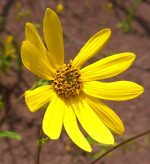 This herbaceous perennial is found from south-central Canada, through eastern and central US to northeastern Mexico where it grows in open forests, woodlands edges, prairies, grasslands, savannas, and disturbed sites such as abandon fields and along railroad tracks. It is a member of the aster family, Asteracea, that also includes daisy, yarrow, and lettuce. Growing from a rhizomatous root system, plants are 2.5 to 7′ tall and have a single light green hairy stem that branches only where the flowers appear. The opposite, lanceolate to ovate leaves are 2.5-6″ long and have short petioles and serrated to toothless margins. The upper side of each leaf is medium green and has small stiff hairs, while the lower surface is pale green and has soft hairs. From mid summer to early fall each plant produces 1-7 flowerheads that are 2-3″ wide and composed of 10-15 yellow ray flowers surrounding a center of 40 or more yellow disc flowers. The bloom time is long and the flowerheads attract bees and butterflies as well as many other insects. The seedheads are eaten by birds and mammals. Plants are a good choice for wildlife, butterfly, and native plant gardens. The genus name, Helianthus, comes from the Greek words helios, meaning sun, and anthos meaning flower and may refer to the resemblance of the flowerhead to the sun. The specific epithet, hirsutus, is the Latin word meaning hairy and refers to the hairs on both the leaves and the stem.
This herbaceous perennial is found from south-central Canada, through eastern and central US to northeastern Mexico where it grows in open forests, woodlands edges, prairies, grasslands, savannas, and disturbed sites such as abandon fields and along railroad tracks. It is a member of the aster family, Asteracea, that also includes daisy, yarrow, and lettuce. Growing from a rhizomatous root system, plants are 2.5 to 7′ tall and have a single light green hairy stem that branches only where the flowers appear. The opposite, lanceolate to ovate leaves are 2.5-6″ long and have short petioles and serrated to toothless margins. The upper side of each leaf is medium green and has small stiff hairs, while the lower surface is pale green and has soft hairs. From mid summer to early fall each plant produces 1-7 flowerheads that are 2-3″ wide and composed of 10-15 yellow ray flowers surrounding a center of 40 or more yellow disc flowers. The bloom time is long and the flowerheads attract bees and butterflies as well as many other insects. The seedheads are eaten by birds and mammals. Plants are a good choice for wildlife, butterfly, and native plant gardens. The genus name, Helianthus, comes from the Greek words helios, meaning sun, and anthos meaning flower and may refer to the resemblance of the flowerhead to the sun. The specific epithet, hirsutus, is the Latin word meaning hairy and refers to the hairs on both the leaves and the stem.
Type: Herbaceous perennial
Bloom: Two-three inch wide flowerheads with yellow ray flowers surrounding a center of yellow disc flowers from mid summer to early fall
Size: 2.5-7′ H
Light: Full to partial sun
Soil: Average, dry to medium moist, well-drained
Hardiness: Zones 2-8
Care: Low maintenance
Pests and Diseases: Downy mildew
Propagation: Seed, division
Companion Plants: Milkweed, asters, goldenrod, ornamental grasses
Photo Credit: Wikipedia